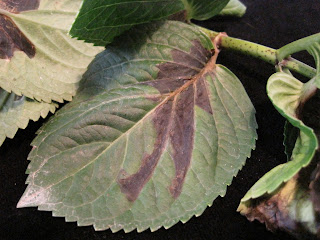 |
| Classic bacterial spot symptoms, notice the yellow halos (Photo: Mike Munster) |
We received a sample of English ivy leaves that had necrotic leaf spots of various sizes. The sample came from a greenhouse production system. We viewed the leaves under a microscope and observed bacteria in all of the spots we checked. We also checked for signs of fungal infection since a fungus in the genus Colletotrichum causes similar symptoms. Typically a yellow halo can be seen around bacterial spots, whereas in the fungal disease, anthracnose, these halos are absent. In this case, the fungus was not observed and bacterial leaf spot was our diagnosis. This is a common disease of English ivy caused by a bacterium in the genus Xanthomonas. While this particular sample was from a greenhouse, this disease is also common in the landscape.
 |
| Bacterial Leaf Spot (Photo: Mike Munster) |
 |
| Leaf with both bacterial leaf spot and anthracnose. Notice the yellow halo associated with the bacterial spot (Photo: Mike Munster) |
Further tests confirmed that the bacterium Xanthomonas was present in the leaf spots. While we did not identify the bacterium to species, presumably it was Xanthomonas campestris pv. hedera, the common cause of bacterial leaf spot on English ivy (Hedera helix). Hosts include other species of Hedera, Schefflera, and Fatsia. Bacteria are spread by water splash (especially by overhead irrigation) and by handling wet plants. Excessive watering and fertilizer applications promote development of this disease. In a greenhouse environment, the bacteria can potentially come in on cuttings.
If bacterial leaf spot is diagnosed, adjacent plants probably have latent bacterial infections in the leaves. Pots, flats, and benches are likely to have surface populations of the bacteria. This is especially true if the plants were under a mist system. Symptomatic plants should be discarded, and adjacent ones either discarded or placed in isolation.
 |
| Bacterial Leaf Spot (Photo: Mike Munster) |
To control bacterial leaf spot in the greenhouse, be sure to start with clean, inspected cuttings. Different cultivars of English ivy have been shown to have different levels of susceptibility to Xanthomonas. Cultivars with some resistance include, Gold Dust, Perfection, Sweet Heart, Eva, California, and Manda Crested. Thoroughly clean and then sanitize pots, flats, surfaces, and tools with steam or chemical disinfectants. There are no effective chemical controls for application directly to the plants, but during propagation copper products can be used to hold back the bacteria somewhat.
 |
| Bacterial Leaf Spot Symptoms (Photo: Mike Munster) |
For more information about control of bacterial leaf spot in the greenhouse click here
In the landscape, always start with disease free plants and use resistant cultivars when possible. Water plants in the morning to allow the leaves to dry out during the day. Do not mist plants and avoid getting the leaves overly wet when watering. Plant plants in areas with low humidity to speed up drying time. Thin plants at the start of each season to increase ventilation in the beds. In established beds, remove and destroy any diseased leaves or stems when you first notice symptoms. Note that English Ivy is an invasive species. It is best used in pots where it can be kept under control. For more information about invasive plant species and planting alternatives click here











